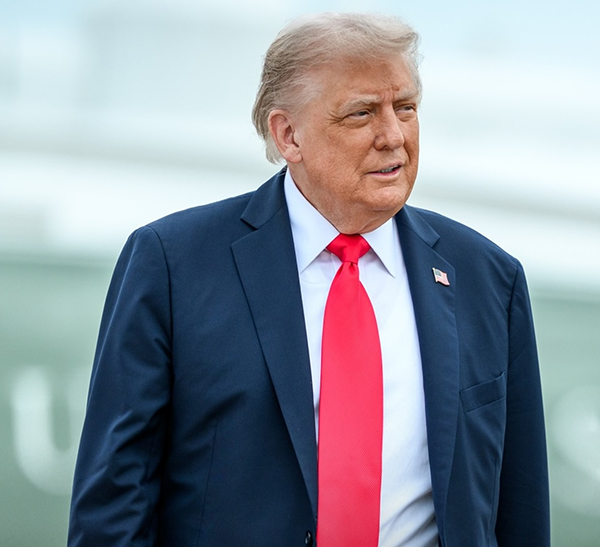President Donald Trump has returned the names of Confederate generals to U.S. military bases that were removed in 2020 by Congress. To columnist Earl Ofari Hutchinson, it’s another sign of Trump’s tendency to cater to southern voters.
Courtesy photo
By Earl Ofari Hutchinson
Contributing Columnist
“We won a lot of battles out of those forts. It’s no time to change. And I’m superstitious, you know?”
As usual, President Donald Trump was being disingenuous in his speech to military personnel at Fort Bragg in June when he feigned superstition about changing the name of U.S. military bases.
This is the first of a two-part series based on Earl Ofari Hutchinson’s latest book, “White Supremacist-In-Chief” (Middle Passage Press).
Trump was not motivated by spells, curses or black magic when he lambasted former President Joe Biden and a congressional mandate to strip the names of Confederate military leaders from U.S. military bases. He had first fumed over the congressional move to strip the bases of their Confederate names in the waning days of his first term.
Then he vetoed the congressional commission’s directive in 2020 to rename the bases. Congress, mostly with Democratic lawmakers, overrode his veto.
Trump, though, was not going to let the matter rest. He made it clear that if he retook the White House that he would move fast to rename the U.S. military bases.
Once back in the White House he wasted no time and ordered the re-renaming of the bases. The only concession the Trump-controlled Defense Department cagily made to quell some of the anticipated uproar over slapping the names of traitors and slave holding Confederate generals back on U.S. bases was to designate the bases with the names of U.S. military honorees who had the same name as the Confederate generals whose names were removed from the bases.
Here was one example from the seven bases that were renamed back to names that formerly had Confederate general names. Fort Lee, in Virginia was originally named after Confederate Gen. Robert E. Lee, renamed in 2023 to Fort Gregg-Adams after Lt. Gen. Arthur Gregg and Lt. Col. Charity Adams — now honored Pvt. Fitz Lee, commended for heroism in the Spanish-American War.
The seven bases were added to two bases — Fort Bragg and Fort Benning — whose Confederate generals names had been dropped and now their original names were sort of restored.
One question that still dangled was why Trump latched onto the issue of renaming military bases after racist traitors with such passion. The answer was race and politics. It welded the two perfectly together.
The removal of statues, monuments, and assorted other public mementoes that honored Confederate war heroes had gathered momentum among a wide segment of the public, but especially African Americans during Trump’s first term. The Southern Poverty Law Center estimated that more than two dozen of these monuments had been removed between 2020 and 2024.
One group in Louisiana, Take Em Down, led a vigorous campaign for the removal of anything that honored a Confederate figure. A spokesperson was blunt, “If you were someone who enslaved Black people or was responsible for the genocide of indigenous people, you are someone that should not be venerated.”
That sparked the predictable backlash from many whites in both the North and South. Trump saw a political opening in the pushback. He could cloak his appeal to white supremacy that the Confederate removal symbolized as simply a noble fight not to rewrite history.
The numbers backed him up. A Morning Consult/Politico poll in 2017 found that a majority of voters said Confederate statues should remain standing. Three years later in 2020, the number of those who backed the statues had dropped.
Even so, more than 40% of voters still said keep the monuments in place. Trump’s outspoken support of the monuments further solidified his formidable support among Southern white conservatives.
Trump understood that the battle to erase the names of Confederate heroes from military bases could not be separated from the ongoing battle to scrap the Confederate flag from statehouses, the sale of the flag and other Confederacy-related items from major retail outlets, and the continued glorification of the South’s treasonous act of rebellion and defiance of the Constitution. That fight was always much more than the mere defense of a symbol of a dead, archaic and disgraceful past in American history.
It was a rallying point for the conservative assault on affirmative action, voting rights protections, and the expansion of civil rights laws. It was no accident that the Confederate flag was proudly and defiantly waved at Tea Party marches, protests and rallies ripping then-President Barack Obama during the first two years of his administration from 2008 to 2010.
It was also no accident that Republican political leaders for years maintained either a stony silence on the removal of the flag and other Confederate monuments from statehouses and other public places or openly backed their continued display. The flag was their handy symbol in their continuing assault on an alleged wildly overreaching, tax and spend federal government that eroded states’ rights and personal freedoms.
The re-renaming of the military bases served the exact same purpose for Trump. It marked him as a president who would do everything in his power to use that symbol for political gain with the bonus of giving yet another encouraging wink and nod to white supremacy.
Earl Ofari Hutchinson is an author and political analyst. His forthcoming book is “White-Supremacist-In-Chief” (Middle Passage Press).




